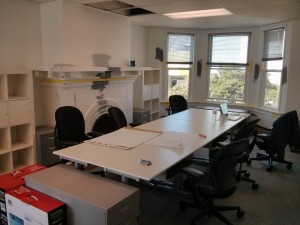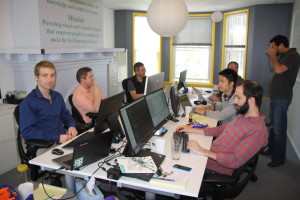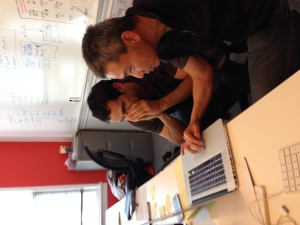Startup has been a household term since the early/mid 90’s when the World Wide Web (now a nostalgic term) began to take the world by storm. Triggered by the popular graphical browser, Mosaic, the blossoming of the Web all of a sudden opened up all sorts of business opportunities, attracting entrepreneurs to try capitalize the newly born eye-catching medium.
A historically well known place for technology entrepreneurship, the Silicon Valley (or more precisely, San Francisco Bay Area) became an even hotter spot for entrepreneurs to swamp in. Many of these entrepreneurs were young energetic college graduates (or drop-outs) in some science/engineering disciplines who were well equipped to quickly learn and apply new things in the computing area. They generally had a fast-paced work style with a can-do spirit. Along with the youthful work-hard play-hard attitude, the so-called startup culture was born. Sun Microsystems was probably a great representative of companies embracing the very culture back in the dot-com era.
So, that was a brief history, admittedly unofficial, of the uprising of startup culture 1.0.
Version 2.0
This isn’t another ex-dot-commer glorifying the good old startup culture in the dot-com days that later degenerated into a less commendable version observed today. Rather, it’s just my observation over recent years the gradual, subtle changes to the so-called startup culture.
Heading into startup culture 2.0 (an obviously arbitrary version number), besides an emphasis of fast-paced and can-do, along came a number of phenomenons including long hours, open-space and the Agile “movement”.
Long hours
In 1.0, we saw a lot of startup technologists voluntarily working long hours in the office. Glorified stories of techies literally camping in the office live on. Company management nowadays still believe (or want to believe) that software engineers working long hours is a signature of startup culture.
In reality, working long-hours is no longer a “voluntary” phenomenon, if it ever was. Why is that? I believe one of the reasons is that a good portion of the techies in startups today are veterans who prefer a work-life balance with a work schedule that focuses on productive hours rather than number of hours. Another reason is that working remote is now a more feasible solution due to improved Internet connectivity at home, thus diminishing the need to stay in the office for network access.
The fact is that serious software engineering requires serious brain-work. One can only deliver a certain number of hours of quality work on any given day in a productive manner. Forcing engineers to pull long hours in the office beyond the normal productive limit might just result in higher code quantity but lower code quality. Worse yet, genuine software engineering enthusiasts tend to contribute bonus work at some ad-hoc high-creativity moments outside of office hours, but the forced long hours will likely kill any stamina or incentive left to do so.
Flexibility in work hours and locale
Back in 1.0, general Internet connection speed was slow. It was common for a good-sized company with nationwide offices to share a T1 line as their Internet backbone, whereas today many residential consumers use connections at an order of magnitude faster than a T1. So, in order to carry out productive work back then, people had to go to the office, thus oftentimes you could find software engineers literally camping in the office.
Given the vastly improved residential Internet infrastructure today, much of the engineering work that used to be doable only in the office in the past can be done at home. So, if a software engineer already has regular office presence, there is little to no reason to work long hours in the office. In fact, other than pre-scheduled group meetings and white-boarding sessions, engineers really don’t have to stay in the office all the time, especially for those who have to endure bad commute.
Open office space
Open-plan office has been advocated since the middle of the 1.0 era. Common office cubes used to be 5-1/2 feet or taller in the old days. People later began to explore opening up a visually-cluttered office space by cutting down about a foot from the cube wall, allowing individuals to talk face to face when standing up while keeping some privacy when sitting down. Personally, I think that’s the optimal setting. But then in recent years, lots of startups adopted cubes with walls further lowered or completely removed, essentially enforcing a surround-sound “multicast” communication protocol all the time for individuals. In addition, the vast open view would also ensure constant visual distractions.
Bear in mind software engineers need good chunks of solitary time to conduct their coding work. Such a multicast plus visually distracting environment isn’t going to provide a productive environment for them. It’s understandable for a cash-strapped early-stage startup to adopt a temporary economical seating solution like that, but I’ve seen many well-funded companies building out such workspace as their long-term work environment.
Agile
Virtually every software engineering organization is practicing some sort of Agile process. I like certain core Agile practices like 2-week development sprint, daily 15-minute scrum, and continuous integration, which I think are applicable to many software development projects. But I’m against mechanically adopting everything advocated in the Agile methodology.
Which aspects of the Agile process are to be adopted for an engineering organization should be evaluated, carried out and adjusted in accordance with engineers skillset, project type and operation environment. The primary goal should be for efficiency and productivity, not because Agile sounds cool.
Insecurity and distrust?
With typically limited budget and tight timeline in mind, management tend to be nervous about whether their engineering hires deliver work as best as they could. Long hours in office would make believe that things are moving along at above the average speed. Open space further eases the anxiety through seeing-is-believing. And frequent sprints and daily scrums ensure maximum work output and microscopic measurement of individuals performance.
If those are the motives observed by the software engineers, most likely they won’t be happy and the most competent ones will be the first to flee. Nor will the management be happy when they don’t see the expected high productivity and find it hard to retain top engineers. The end result is that despite all the rally of fun, energetic startup culture on the company’s hiring web page, people hardly feel fun or energy there.
What can be done better?
Management:
- Give your staff benefit of doubt — It’s hard to let go of the doubt about whether people are working as hard as expected, but pushing for long hours in the office and keeping them visually exposed at their desks only send a signal of distrust and insecurity. By pushing for long hours in the office, management are in essence commodifying software engineering work to become some hourly-paid kind of mechanical work. It’ll only backfire and may just result in superficial punch-clock office attendance with low productivity. I would also recommend making the work hours as flexible as possible. On working remote, a pre-agreed arrangement of telecommuting would go a long way for those who must endure long commute. People with enough self-respect would appreciate demonstrated trust from the management and it would make them enjoy their job more, thus produce better work.
- Work healthy — Work hard and play hard is almost a synonym of startup culture that we believe fun is a critical aspect in a startup environment. But throwing in a ping pong or foosball table would not automatically spawn a fun environment. In building out a work environment, I would argue that “work healthy” perhaps should replace “fun” as the primary initiative. I think providing a healthy working environment will lead to happier staff, better productivity, and fun will come as a bonus. Common ways to achieve that include suitable office plan, ergonomic office furniture, natural lighting, facility for exercise, workout subsidy programs, healthy snacks, or even a room for taking naps. Speaking of naps, I think it’s worth serious consideration to embrace it as part of the culture. Evidently, a 15-30 minutes of nap after lunch can do magic in refreshing one’s mood and productivity for the remaining half of the day.
- Adopt Agile with agility — Take only what best suit your staff’s skillset, project type and operational environment. Stick to the primary goal of better productivity and efficiency, and add/remove Agile practices as needed. It’s also important that you regularly communicate with the staff for feedback and improvement, and make adaptive changes to the practices if necessary.
- Product development feedback — Despite all the development methodologies with fancy names, there is often a disconnect between actual engineering progress and product development plan. A common tactic is to assemble a unfulfillable aggressive development plan to try push for maximum engineering output. Unfortunately, such practice often results in disrespect to development timelines or inferior product quality with a ballooned overdue tech debt. A better approach would be to maintain an effective feedback loop that constantly provides data (including actual progress estimates, tech debt clearance needs, etc) between product and engineering staff. The feedback allows product development staff to proactively plan out future feature sets that engineers can more realistically commit to delivering.
- Lead by example — Too often do we see management handing down a set of rules to the staff while condescendingly assuming the rules don’t apply to themselves. It’s almost certain such rules will at best be followed superficially. Another commonly seen phenomenon is that management rally to create a culture which conflicts in many ways with their actual belief and style. They do it just because they were told they must create a culture to run a startup operation, but they ignore the fact that culture can only be built and fostered with themselves genuinely being a part of it. It cannot be fabricated.
Individuals:
- Honor the honor system — There may be various reasons contributing to the commonly seen distrust by the management. Unsurprisingly, one of them comes directly from individuals who abuse some of the employee benefits meant to be used on discretion. Perhaps the most common case is claiming the need for work-from-home with made-up reasons or without actually putting in the hours to work. Well, you can’t blame people’s distrust in you unless you first honor the honor system . For instance, when you do work from home, stick to the actual meaning of work-from-home. Also, making your availability known to those who need to work closely with you would be helpful. One effective way, especially for a relatively small team, would be to have a shared group calendar designated for showing up-to-date team members availability.
- Self discipline — Again, using work-from-home as an example, one needs to have the self-discipline to actually put in decent amount of hours to work. It’s easy to be distracted, for instance by your family members, when working at home, but it’s your own responsibility to make necessary arrangement to minimize any expected distractions. It’s also your obligation to make it clear to your teammates in advance when you will be unavailable for scheduled appointments or what-not.
- Reasonable work priority — For unplanned urgent family matters, no one will complain if you drop everything to take care of them. However, that doesn’t necessarily justify you should frequently compromise your attendance to work for all sorts of personal events, unless that’s a pre-agreed work schedule. Bottom line, if your career matters to you, you shouldn’t place your job responsibility way down your priority list from routine personal/family matters.
- Active participation — Most software engineers hate meetings, feeling that they consume too much of their time which could otherwise be used for actually building products. I think if the host and the participants are well-prepared for the meeting, it’ll successfully serve its purpose (e.g. information sharing, brainstorming, team building, etc) with minimum negative feeling. A unprepared participant attending a meeting carrying a feed-me mindset will likely feel the meeting time-wasting. With some preparation, chances are that you will be a lot more engaged in the discussion and be able to provide informed input. Such active participation can stimulate collective creativity and foster a culture of “best ideas win”.
- Keep upgrading yourself — This may sound off-topic, but keeping yourself abreast of knowledge and best-practices in the very area of your core job responsibilities does help shape the team culture. Constant self-improvement will naturally boost up one’s confidence in their own domain which, in turn, facilitates efficient knowledge exchange and stimulates healthy competition. All that helps promote a high-efficiency no-nonsense culture. The competitive aspect presents healthy challenge to individuals, as long as excessive egos don’t get in the way. As a side note on “upgrading”, between breath and depth I would always lean toward depth. These days it’s too easy to claim familiarity of all sorts of robust frameworks and libraries on the surface, but the most wanted technologists are often the ones who demonstrated in-depth knowledge, say, down to the code level of a software library.
Final thoughts
Startup culture 1.0 left us a signature work style many aspire to embrace. It has evolved over the years into a more contemporary 2.0 that better suits modern software development models in various changeable competitive spaces. But it’s important we don’t superficially take the surface values of all the hyped-up buzzwords and mechanically apply them. The various cultural aspects should be selectively adopted and adjusted in accordance with the team’s strength and weaknesses, project type, etc. More importantly, whatever embraced should never be driven by distrust or insecurity.





